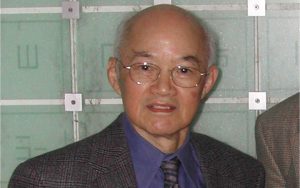
Amy and T.Y. first learned about MIT during their undergraduate studies (two years apart) in China with two professors who were educated at MIT. Their first year general chemistry lecturer sported a big MIT belt buckle. (He demanded the memorization of the entire periodic table for his quiz.) Another engineering professor, newly returned from MIT, adopted the highly regarded Principles of Chemical Engineering, published by MIT faculty members, as his course text book. In addition, both Amy’s brother-in-law (Y.T. Li) and T.Y.’s brother (S.F. Shen) received their Engineering D.Sc. at MIT.
Amy was a research assistant working in Professor George Scatchard’s laboratory in Room 6-226, whereas T.Y. was a research associate in Professor Arthur Cope’s group in 2-301. In the early 50’s, there was only one telephone in the hallway shared by several labs. As both Amy’s and T.Y.’s lab had windows facing a common courtyard, T.Y. would just look out to Amy’s window to conduct private and instant communication with her. A white lab towel on her windowsill would signal that she had finished her albumin-binding experiments, and that she was ready for a lunch break in Walker Memorial for her favorite BLT. Working with Professor Scatchard was also highly stimulating culturally for both Amy and T.Y. Professor and Mrs. Scatchard (who taught music at Smith College) were devoted to music. More than once, Amy and T.Y. were allowed to use Scatchards’ seasonal tickets to enjoy the Boston Symphony Orchestra concerts.
On a hot sunny Saturday in June 1953, Amy and T.Y. were married in the Mount Vernon Church in Boston (now demolished) on Mass. Ave. near the Harvard Bridge. A small group of departmental faculty, staff and students – led by Professors Scatchard, Cope, and Amdur, and their wives — walked across the bridge to the wedding. The physical and organic chemistry guests sat on hers or his sides of the aisles respectively, reflecting the different disciplines of the bride and groom.
After marriage, Amy’s research work was interrupted by maternity leaves. (Occasionally she would park a baby pram on the lawn in front of the Building 10 Dome.) Later, two of the Shen children, Theodore (BS ‘78) and Evelyn (MA ‘90) became students in the department as well. Their high school chemistry teacher Dr. Dorothea Hoffman was Cope’s graduate student at Bryn Mawr College, who first observed the 1940 “Cope sigmatropic rearrangement” phenomenon in her meticulous fractional distillation of unsaturated barbiturate precursors. (She was later honored as ACS High School Chemistry Teacher of the Year with a nomination from Merck.)
It was most gratifying to Amy that her two and half years of experimental data on the binding characteristics of anions to serum albumin – contributed to the theoretical derivation of the Scatchard Equation (JACS, 1957, 1959). The Scatchard Plot has since become a fundamental measure in broad biomedical investigations of enzymes, ligands, and receptors for basic mechanism of action studies and new drug development.
In 2012 T.Y. established an endowed summer graduate fellowship in his wife’s name. The Amy Lin Shen Summer Fellowship will provide graduate student financial assistance to female students working in the area of physical chemistry research. Amy is delighted to be helping facilitate physical chemical research by female graduates.
T.Y. began his work with Professor Cope on the conversion of carbohydrates to versatile synthetic intermediates (Cuban Sugar Project). It then entwined with Cope’s new interest in the trans-annular “proximity effect” with the enantiospecific synthesis of optically active heterobicyclo[3,3,0] structures. The pharmacological screening of those novel compounds by Merck Laboratories (though all inactive) kindled T.Y.’s career interest in medicinal chemistry.
A highlight of T.Y.’s research in the Merck Research Labs was the synthesis of indomethacin as a leading non-steroidal anti-inflammatory drug (NSAID) in 1961. More satisfying to him scientifically, it was characterized as a potent and specific inhibitor of prostaglandin cyclooxygenase by the Nobel laureate Dr. John Vane in 1971, and served as a valuable biochemical research probe with 40,000 citations in PubMed to date.
Soon after joining the Department, T.Y. was much impressed by the stimulating and inspiring influence of the Arthur D. Little Visiting Lectureship. Outstanding speakers worldwide were invited to spend two weeks in the department to interact with faculty and students, thus promoting scientific collaborations and graduate student exchanges. T.Y.’s graduate research mentor at University of Manchester, Sir Ewart Jones, was the visiting lecturer in 1952. Then, Lord Alexander Todd (Cambridge University) came and lectured in 6-120. He described the development of a novel condensation reagent, carbo di-imide, in his laboratories with Professor Gobind Khorana. It forms phosphodiester bonds in oligonucleotide synthesis under very mild conditions. An innovative application of carbo di-imide reagents to the formation of peptide bonds was soon accomplished in Professor John Sheehan’s labs. It has much facilitated the synthesis of superior beta-lactam antibiotics in many academic and pharmaceutical labs.
When T.Y. received a Merck Director’s Scientific Award in 1976, the award was used to establish a visiting lectureship in the department. Since then, many distinguished speakers — including two pre-Nobel laureates, (inaugural speaker) Bengt Samuelsson (Karolinska Inst.), and Alfred Gilman (University of Virginia) — have visited the department to deliver the T.Y. Shen Lectures in Biological Chemistry. Recently, the lectureship was further supported by the department and Shen family donations.
After 30 years in Merck Laboratories, T.Y. took an early retirement from his research vice presidency in 1986 and accepted a chair professorship at the University of Virginia, which was jointly endowed by the Merck Foundation and the State of Virginia. He continued his research in bioactive natural products and receptor-mediated drug targeting until 2001. He was named an inaugural member of the American Chemical Society Division of Medicinal Chemistry Hall of Fame in 2007.
